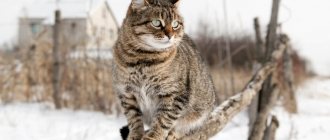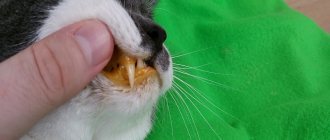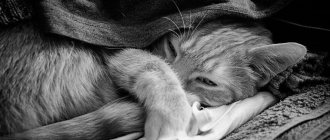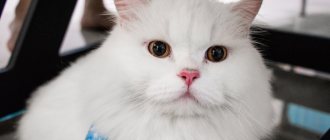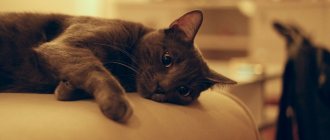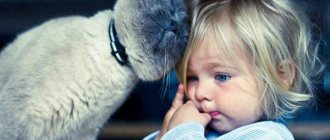5028Administration
Cats are very active, move a lot and are constantly near people, vigilantly monitoring the activities of their owners. All this also requires a lot of energy and strength. And the cat’s heart copes with the function of saturating the body with oxygen and energy.
What is the function of a cat's heart? What is its structure? What is the most common disease in a cat?
© shutterstock
Function and principle of action of the heart
The heart is an internal pump, a muscle that pumps blood, supplying the cat’s body with oxygen and nutrients and removing carbon dioxide from the organs. In this case, one side of the heart, the right, pumps blood only to the lungs. The left one pumps blood to the rest of the cat’s body organs.
Interesting information about cat blood. It turns out that the formula and composition of a cat’s blood does not correspond to any other animal. Blood clots very quickly and its reaction to some chemicals is unique (this point is still being studied). But that's not all. Scientists have found that the composition of the blood of each cat is different, just like that of humans. There is a certain system that divides blood into groups. This is all that the researchers have found out so far.
The essence of the heart's action is to force blood to move through the cat's body. The heart pumps blood into the lungs. There it is enriched with oxygen and returned to the muscle.
Then it is sent through the vessels throughout the body, and some of it seeps into the tissues and collects in the lymphatic system. In this system, the blood is purified by passing through the glands and receives a certain number of lymphocytes. And all this movement is driven by the heart pump. It’s worth getting acquainted with the structure of this pump and finding out what the structure of a cat’s heart is.
© shutterstock
Causes
- Genetic diseases of the cardiovascular system and congenital heart defects (non-occlusion of the ductus botallus, pulmonary stenosis)
- Acquired defects and arterial hypertension.
- Infections, poisoning or inflammatory diseases of the heart or lungs.
- Malfunctions of the endocrine system - hyperthyroidism and diabetes.
- Arrhythmias.
- Cardiomyopathies.
The most common cause is cardiomyopathy - a dysfunction of the heart muscle, which can be either dystrophic or hypertrophic in nature.
In dystrophic or dilated heart failure, heart failure develops due to excessively dilated cavities that prevent normal ejection volume.
With myocardial hypertrophy, the volume of blood ejected decreases due to a decrease in the cavities of the excessively enlarged heart muscle.
In addition to the direct causes leading to the development of deficiency, there are a number of predisposing factors: obesity, adynamia, poor nutrition, frequent infections and weakened immunity.
Anatomy of the heart
The structure of the cat's heart muscle looks the same as in birds, and in humans, and in any mammal, it consists of 4 parts, chambers:
- The upper chambers are called the left and right atria.
- Next comes the middle layer. This muscle is called the myocardium.
- The lower hollow chambers are the ventricles.
Blood moves through the body due to the contraction of the ventricles.
What is the size of a cat's heart? It is believed that while the anatomy of the structure and arrangement of organs is similar to other animals, the cat’s heart is small. Depending on the breed and age, we can say that it occupies only 2 intercostal spaces - this is a very small size. And the heart doesn’t look special or big from the outside; it weighs from 12 to 15 grams.
If the cat’s body is healthy, it has a sufficient amount of hormones and everything is normal with the autonomic system, then this affects the main organ, and the cat will not have heart problems. The rhythm, the force with which the heart muscle contracts and the frequency of contractions, the work of the vascular system, its contraction and expansion, all depend on whether the cat has certain problems or hormonal heart disease.
How do you know if there is a disease in the heart itself? Several factors may indicate this. For example, a cat’s weight exceeds the norm. A symptom may also be that the cat is tired, or that after intense games her heart almost jumps out of her chest. This, if not a sign of the disease itself, is a reason to start worrying and start checking.
Symptoms
The appearance of bright clinical symptoms of cardiomyopathy in cats indicates that the pathological process in the heart is already sufficiently developed, and it is no longer possible to cure the sick animal.
- Shortness of breath (heavy breathing) An accumulation of fluid forms in the pleural cavity (the slit-like space between the layers of the pleura - the membranes surrounding each lung). As a result, the cat, with little physical activity or even just at rest, breathes with its tongue or stomach hanging out, rather than with its lungs.
- Attacks of suffocation
- Fainting, loss of consciousness , accompanied by shallow breathing and thready pulse
- Cough When the heart muscle increases in volume due to pathology, it begins to put pressure on the nearby trachea, resulting in a reflex cough in the animal. But this symptom is usually characteristic of dogs; cats with heart disease rarely cough. A characteristic symptom for cats is shortness of breath.
- Ascites (fluid in the abdominal cavity), edema
- Non-productive vomiting , drop in body temperature below 37°, general weakness
The remaining symptoms of heart failure are not specific and can occur with other diseases. These are: limited physical activity, general weakness and fatigue, drowsiness, loss of appetite. Thus, if a cat sleeps all the time, then perhaps this is not a manifestation of its phlegmatic character, but one of the signs of a disease of the cardiovascular system.
Many cats can lead active lives until their heart becomes fundamentally deformed and its chambers become so large that blood flow slows, causing blood clots to form. One such large blood clot can block vital arteries.
Kittens with heart disease are weak, developmentally delayed and do not gain weight well.
Cat heart disease
What do pet owners need to know about what heart problems there are in cats and how to recognize them? Most often, furry owners encounter a problem such as cardiomyopathy; the causes of the disease are different, and therefore there are several varieties :
- Hypertrophic;
- Dilation;
- Restrictive;
- Intermediate.
© shutterstock
Diagnostics
It is very important to identify the disease in the initial stages of development. This can be done by an experienced doctor in a well-equipped clinic, since in this case a banal phonendoscope will not do.
It is necessary to carefully collect all the information you know - what infectious and chronic diseases your pet suffers from, how long ago the symptoms of the disease began, the presence of vaccinations and changes in the animal’s behavior.
General examination – will help with preventive examinations. It helps to identify the disease in the absence of external manifestations, based on listening to murmurs, rhythm disturbances and visualizing the cardiac impulse (a sign of myocardial hypertrophy).
It is definitely worth measuring blood pressure to rule out hypertension and identify disorders in one of the blood circulation. With reduced values, dilated heart failure can be suspected.
General blood tests and biochemistry are performed. It is also worth taking blood samples for thyroid hormones to rule out hyperthyroidism. And check for increased sugar levels.
ECG is the main way to detect abnormalities in the heart. Allows you to identify functional changes in the myocardium and the presence of arrhythmias. A more clear picture of heart failure can be seen with an ultrasound scan.
It is also necessary to take an x-ray, on which you can see the expansion of the borders of the heart, its displacement from its normal position, fluid in the heart sac and pleural cavity, as well as ascites.
Treatment
If you notice signs of heart failure in your pet, be sure and urgently contact the clinic. Acute oxygen starvation can lead to asphyxia and death of the animal!
Treatment should begin with a salt-free diet for your pet and reducing the total amount of liquid he drinks. It is necessary to give moderate physical activity; you can include walks in the fresh air for these purposes. During exercise, carefully monitor the animal's condition to avoid shortness of breath and increased cyanosis.
Drug therapy should be carried out taking into account the severity of the disease and changes in the heart muscle. The main effect of the drugs should be aimed at normalizing blood supply, restoring the functioning of the myocardium and blood flow.
To remove fluid from the cavities, diuretics are prescribed. The drug of choice is hydrochlorothiazide, which has minimal side effects when taken in low dosages. Should be taken in the morning.
For severe symptoms of CHF, furosemide is used; it begins to act within 15 minutes after administration.
The main drugs used to treat heart failure are ACE inhibitors. These include enalapril and captopril. The dosage is selected strictly individually. During therapy, the animal’s condition must be monitored and blood pressure measured.
Cardiac glycosides are aimed at improving myocardial trophism. Digoxin is used for treatment, but its use is contraindicated in the presence of arrhythmias. Prescribed in minimal doses, gradually increasing to the optimal amount over the course of a week.
To improve pumping function, beta-blockers are used - bisoprolol, metaprolol. The starting dose should be an eighth of the expected dose, and increased every 2 weeks.
Standard drug therapy regimens:
- Only ACE inhibitors are used in the treatment of the initial stages of the disease.
- ACE inhibitor and diuretic - with the development of insufficiency of 2 or 3 degrees.
- ACE inhibitor, diuretic, cardiac glycoside and beta-blocker are the most common and “gold standard” therapy in veterinary medicine.
Internal structure of a cat
The location and functioning of the internal organs, as well as the internal structure of the cat, are in many ways similar to the structure of other mammals. However, there are also differences that are unique to this species of animal.
The main organ of the circulatory system is the heart - a hollow muscular organ located inside the chest, namely behind the median sternum. It is worth noting that the weight of a cat's heart depends on body weight, namely 0.6 percent of body weight. The heart consists of two atria and two ventricles.
A cat has 2 circles of blood circulation . Blood circulation occurs through arteries leading from the heart to capillaries, penetrating all internal organs and tissues.
Metabolism takes place there, then blood, which is saturated with carbon dioxide and waste products of the body, flows through the veins leading to the heart. Veins form the 2nd, pulmonary circulation .
Venous blood enters the right ventricle of the heart, then through the pulmonary arteries into the lungs.
A cat's respiratory system is designed to function well in a variety of environmental conditions. The task of the organs is to ensure gas exchange and oxygen delivery to the tissues of the body. They also play the role of excretory organs, through which excess moisture and harmful gases are removed, and also participate in heat exchange, removing excess heat from tissues.
A cat's respiratory system consists of:
- nose,
- larynx,
- nasopharynx,
- trachea,
- bronchi,
- lungs.
The lungs are the main organ of the respiratory system.
A paired organ that consists of 2 lobes that occupy most of the chest.
They consist of alveoli - that is, pulmonary vesicles that are tightly intertwined with a network of capillaries, serving as conductors during gas exchange.
Something else interesting: Cat skeleton
In cats, the respiratory organs are covered with a mucous membrane that serves as their protection.
When breathing, air enters the larynx through the nose, and from there into the bronchi and lungs.
If the body or environment temperature is elevated, or the animal is in an excited state, its breathing rate increases. There are times when a cat breathes with an open mouth.
The cat's digestive system consists of:
- oral cavity,
- throats,
- esophagus,
- stomach,
- small and large intestines,
- pancreas,
- gallbladder,
- duodenum.
The cat's chewed food from the oral cavity enters the esophagus, which is a muscular tube that can increase in diameter if necessary to push food into the stomach.
The esophagus is covered on the inside with mucous membrane.
Saliva allows food to be partially broken down while still in the mouth. Next, the digestion process continues in the stomach, which is located in the front of the peritoneum.
The cat has a single-chamber stomach, covered from the inside with a mucous membrane, which produces gastric juice necessary for the subsequent processing of food.
2 cone-shaped openings open from the stomach, the 1st of which connects the stomach with the esophagus, the 2nd with the duodenum.
Food from the stomach enters the small intestine, where the final processing of food occurs. The small intestine is a long thin tube twisted into several loops. Its length is 4 times the length of the cat's body.
Food inside the intestines is affected by a pancreatic enzyme.
From the small intestine, unprocessed solid food remains enter the large intestine, where they are enveloped in mucus, which is secreted by the walls of the large intestine.
It consists of 3 elements:
- cecum (appendix),
- colon,
- the rectum, which removes compressed feces from the body.
A cat has anal glands on the sides of the anus, which secrete a secretion with a pungent odor. In addition to the excretory function, the rectum maintains bacteriological balance in the animal’s body.
Something else interesting: Biological characteristics of cats
The organs of the urinary system are needed to remove excess fluid from the animal’s body. Consists of:
- kidneys,
- bladder,
- urinary tract - ureters.
Urine is formed in the kidneys, or more precisely, in the renal pelvis, from which it flows through the ureters into the bladder, where the closing muscle prevents spontaneous urination.
urethra is different: stenoses are special narrowings that serve to facilitate the faster passage of sediment present in the urine.
The reproductive system in cats consists of testicles and vas deferens, which open into the urethra. Through it, sperm enters the reproductive organ.
Testicles are the sex glands of cats. They are located in the scrotum, which is a fold of skin at the base of the penis. They produce male reproductive cells, namely sperm.
Internal genitalia of a cat:
- Ovaries. They produce eggs.
- the fallopian tubes;
- uterus.
External genitalia of a cat:
In cats, the endocrine glands are of great importance for life:
- Adrenal glands;
- Hypothalamus;
- Thyroid.
Source: https://ourkoshki.ru/stroenie-koshki/vnutrene-stroenie-koshki.html
Pictures and videos
Figure 1. “Normal and hypertrophied heart”
Figure 2. “Ascites in cats secondary to heart failure”
Figure 3. “Acute left-sided heart failure”
In Photos B and D you can see congestion and enlargement of the left atrium.
Video 1. “Hypertrophic cardiomyopathy”


